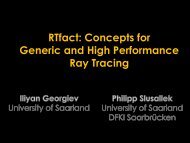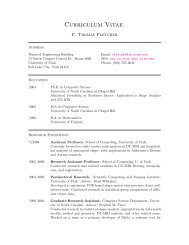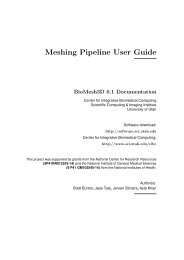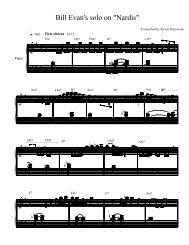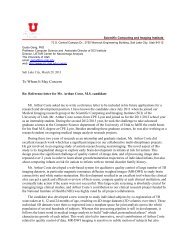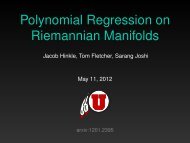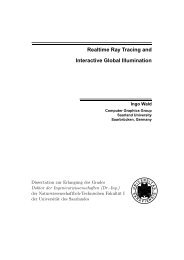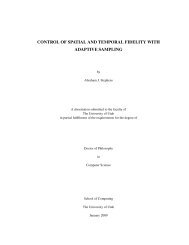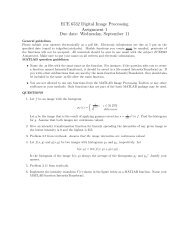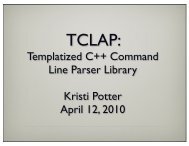SCIRun Forward/Inverse ECG Toolkit - Scientific Computing and ...
SCIRun Forward/Inverse ECG Toolkit - Scientific Computing and ...
SCIRun Forward/Inverse ECG Toolkit - Scientific Computing and ...
You also want an ePaper? Increase the reach of your titles
YUMPU automatically turns print PDFs into web optimized ePapers that Google loves.
elements. Then (two-dimensional) basis functions (again usually low-order polynomials) are<br />
used to approximate the quantities of interest between the nodes of the resulting surface<br />
meshes. Given this discretization, after manipulation of the resulting integral equation,<br />
the integrals required can be computed through a series of numerical integrations over the<br />
mesh elements. In the BEM method, these integrals involve as unknowns the potential <strong>and</strong><br />
its gradient. The integration involves the computation of the distance between each node<br />
within the surface <strong>and</strong> to all others surfaces. In complicated geometries, <strong>and</strong> in all cases<br />
when the node is integrated against the points on its “own” surface, there are numerical<br />
difficulties computing these integrals. In those cases there are a number of sophisticated<br />
solutions which have been proposed in the literature (<strong>and</strong> some of them are adopted in the<br />
<strong>SCIRun</strong> implementation). The result of all these integrals is a transfer matrix, which again<br />
we will denote A, relating the source potentials or currents to the unknown measurement<br />
potentials. In the BEM case, because of the all-to-all nature of the integrations required,<br />
this matrix will be dense, not sparse. On the other h<strong>and</strong>, the size of the equation will be<br />
directly determined by the number of measurements <strong>and</strong> sources rather than the number of<br />
nodes in the entire domain. (We note that there is an alternative formulation of the BEM<br />
method which retains the potentials at all nodes on all surfaces, <strong>and</strong> which can be reduced<br />
to the transfer matrix described here, but we omit the details as usual.)<br />
2.3 Solutions to the <strong>Inverse</strong> Problem in the <strong>Forward</strong>/<strong>Inverse</strong> <strong>Toolkit</strong><br />
To describe the solution to the inverse problem in a manner useful for this toolkit, we start<br />
with two different equations, depending on whether the activation-based or potential-based<br />
source models were used. Both approaches assume the availability of a forward transfer<br />
matrix A, calculated by any appropriate method, including either FEM or BEM.<br />
In the activation-based case, the source model is that the unknowns are an activation<br />
surface. (That is, activation times as a function of position on the heart surface, which we<br />
denote as τ(x), where x indicates position on the heart surface.) The assumptions required<br />
for the activation-based model imply that the temporal waveform of the potential (<strong>and</strong><br />
current) at each source node has a fixed form, the same at all locations on the surface.<br />
This is assumed to be either a step function or a smoothed version of a step function (using<br />
piecewise polynomials or inverse trigonometric functions). We denote this function as u(t).<br />
Thus the relevant forward equation can be written as<br />
∫<br />
y(p, t) =<br />
x<br />
A p,x u(t − τ(x)) dx (2.7)<br />
where the integral is over the heart surface, A p,x is the element of A relating source node x<br />
to measurement node p, <strong>and</strong> y(p, t) is the measurement surface potential at any time t <strong>and</strong><br />
at a position p on the body surface. One advantage of the activation-based formulation is<br />
that the number of unknowns over an entire cardiac cycle is the number of solution nodes<br />
taken on the heart surface. On the other h<strong>and</strong>, as can be seen in Eq. (2.7), the forward<br />
equation is non-linear in the unknown activation times.<br />
In the potential-based case, the forward matrix can be applied in a more straightforward<br />
manner. If we collect all measurements at a given time t into a vector y(t) <strong>and</strong> the potential<br />
10 Chapter 2



